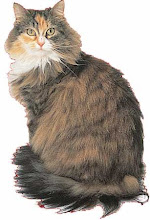Maine Coon Cats and Polydactyly or Polydactylism
Those catcher's mitts on your cat not only attract attention but make him a rather endearing fellow in many circles. Those many-toed felines who sport the extra digits are called polydactyls (polys). Now usually this means the cat has one or two extra toes on each front paw as opposed to the normal 18 digits (4 on rear paws and 5 on the front). That being said, you will also find polys with up to 8 and sometimes ten extra toes.
Most often the front and rear feet have the same number of extra toes – but not always. This appears to vary from cat to cat. It seems a poly will usually only have this distinctive trait on the front feet. But, as with anything else in the world of genetics, the general rules don't always apply and some polys are poly front and back feet. Some can even have just poly back feet.
Polycactyly seems to be more common in the foundation lines of the Maine Coon cat (one of the oldest breeds in North America) as the more modern purebreds are rarely polydactyls. The story goes that most polys were culled out of the breed years ago. That hasn't stopped some breeders from still working with them – thank heavens!
It seems that over time most cat associations have automatically disqualified polys from competition in the purebred classes. There was quite the uproar about that and finally the AFCA, and other cat registries (CFA, TICA, CFF, MCBFA) added a "Household Pet" class that allows the poly trait. By the way the gene for polydactylism is considered to be dominant. That means you can't have a poly kitten born unless one of its parents is also a poly. So if you do the math here, that would mean a kitten with a poly parent has about a 40 to 50 percent change of inheriting those delightful paws. Usually but not exclusively it’s the forefeet that show the poly trait, including extra dewclaws.
Where does the term polydactyly come from? Its actual origin is Greek, with poly meaning many and the daktulos meaning fingers, and you will find a higher population of these charmers in New England. Without getting into the full story, it seems this trait may have come from cats brought from England by ship to the Boston area. Interesting note: you won't find many polys in Europe as they just about became extinct during medieval times. They were regarded as witches familiars.
Pssssst! Did you know the White House once had a resident poly? He belonged to President Theodore Roosevelt. We hear tell Slippers had a lovely pampered life. And of course the most famous of all poly cat owners was Ernest Hemingway. He came into possession of his much beloved Maine Coon cat as a gift from a drinking buddy. To this day there are about 70 descendents or more wandering around the Hemingway estate in Key West. You can get to visit with them since the estate is open to the public.
Being a polydactyl is not life threatening for cats that have this trait. About the only time they have a bit of difficulty is when they are wet behind the ears youngsters just learning to walk, climb and play. It's well worth the entertainment to watch them grow up and find their feet. In later life polys can actually be very nimble in the dexterity department and have been known to single mittedly catch things thrown to them. If that isn't hilarious enough, watch your Maine Coon cat learn how to open cupboard doors and unhook latches. It's amazing!
If you have enjoyed this article about grooming your Maine Coon Cat then please feel free to reprint it as it is. This resource box must be included with the article. Please visit and link to my blog at www.world-of-maine-coon-cats.blogspot.com.
18 ways to stop cat urine odour
Get rid of your cat urine odor problem once and for all!
You don't have to spend hundreds of dollars and hours of time cleaning cat puddles. You don't have to be angry with your kitty.
Here's 18 kitty-researched and cat-tested solutions.
I guarantee one going's to work for you.
Check out 18 ways to stop cat urine odour
You don't have to spend hundreds of dollars and hours of time cleaning cat puddles. You don't have to be angry with your kitty.
Here's 18 kitty-researched and cat-tested solutions.
I guarantee one going's to work for you.
Check out 18 ways to stop cat urine odour
Sunday, 4 May 2008
Subscribe to:
Post Comments (Atom)

No comments:
Post a Comment